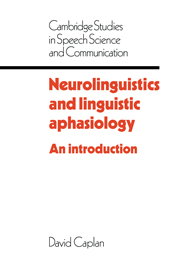Book contents
- Frontmatter
- Contents
- Preface
- Part I Introduction
- Part II Clinical aphasiology and neurolinguistics
- 3 The discoveries of Paul Broca: localization of the “faculty for articulate language”
- 4 Classical connectionist models
- 5 Extensions of connectionism
- 6 Objections to connectionism
- 7 Hierarchical models
- 8 Global models
- 9 Process models
- 10 Overview of clinical aphasiology and neurolinguistics
- Part III Linguistic aphasiology
- Part IV Contemporary neurolinguistics
- References
- Author index
- Subject index
- Frontmatter
- Contents
- Preface
- Part I Introduction
- Part II Clinical aphasiology and neurolinguistics
- 3 The discoveries of Paul Broca: localization of the “faculty for articulate language”
- 4 Classical connectionist models
- 5 Extensions of connectionism
- 6 Objections to connectionism
- 7 Hierarchical models
- 8 Global models
- 9 Process models
- 10 Overview of clinical aphasiology and neurolinguistics
- Part III Linguistic aphasiology
- Part IV Contemporary neurolinguistics
- References
- Author index
- Subject index
Summary
In this chapter we shall review the work of two men, Pierre Marie (1906a; b) and Kurt Goldstein (1948), who developed models of aphasia in which a disturbance of a single functional capacity was the predominant cause of all of the signs and types of aphasia. Both investigators accepted the existence of several aphasic syndromes; neither claimed that a sole factor was adequate to describe all the various manifestations of aphasia. Despite this, their major contributions lie in the emphasis each gave to a single factor in describing and accounting for behavior, and in their attempts to explain the apparent variety of aphasic symptoms as the effect of a disturbance of the single factor they identified in difficult circumstances. In Marie's case, this attempt took the form of an anatomical analysis, while Goldstein's account was mainly psychological.
In his first writings, which were widely publicized and highly controversial, Marie (1906a) argued that the classification of aphasics into different clinical sub-types was an error. He argued that there was only one true aphasia, in which comprehension of language was disturbed as part of a deficit in general intelligence. This aphasia was Wernicke's aphasia, and it occurred after a lesion in the posterior areas of the brain, particularly the temporo-parietal junction of the dominant hemisphere.
Marie acknowledged that not all aphasic patients manifest an obvious disorder of speech comprehension. He claimed that the disorder of comprehension in aphasia could be relatively mild and might only be manifested through complex tests. He suggested that an adequate test was to ask patients to carry out three-part commands.
- Type
- Chapter
- Information
- Neurolinguistics and Linguistic AphasiologyAn Introduction, pp. 105 - 118Publisher: Cambridge University PressPrint publication year: 1987

